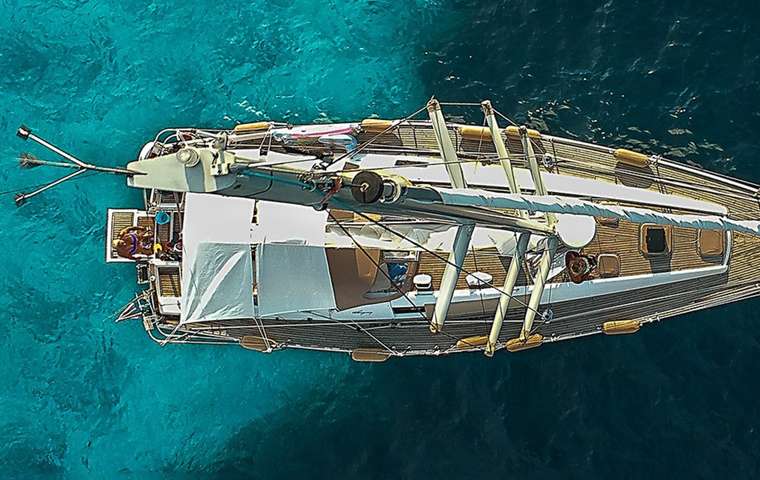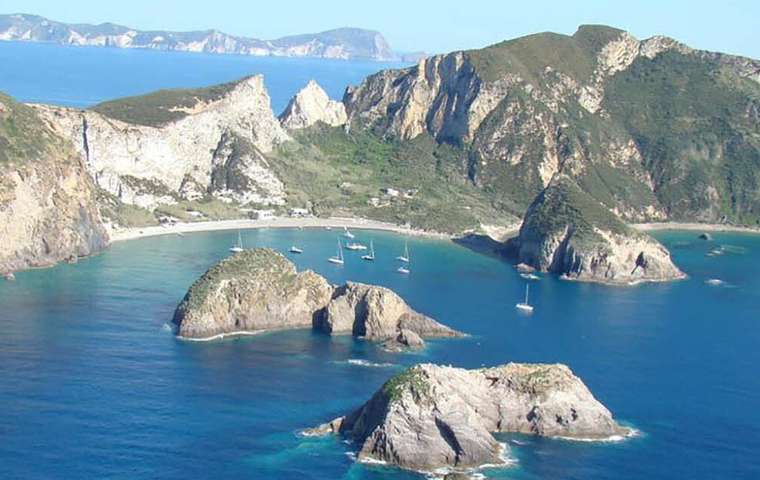
Guide to the most beautiful destinations in the Pontine Islands archipelago
Six small, wild and almost uninhabited islands off the coast of Latium conceal water so crystal clear blue it looks like that of an artificial swimming pool. Try it to believe it!
Easily reached by sailboat or catamaran from the coasts of southern Lazio or from around Naples, the Ponzian Archipelago offers a taste of island hopping among six islands that are fairly close to each other but not so close as to prevent beautiful stretches of sailing. The scents of the Mediterranean maquis, the white color of the cliffs, the deep caves to be discovered by tender, and the transparent waters to dive deep into will accompany you on your journey. From the famous Chiaia di Luna in Ponza, through the Faraglioni di Mezzogiorno in Palmarola and up to the pastel-colored houses of Ventotene, it will be a pleasure to discover one by one the wonders of this archipelago with a Parthenopean flavor, little known and yet rich in history that has come down to us from the days of ancient Rome.
The best period
Visiting the Pontine Islands, or Ponziane Islands, by sailboat is possible from April to October: in spring and early fall temperatures are mild, while in summer they are warm and very sunny. Perfect to visit as early as spring during long bridges, they are also popular for summer weeks to discover them in all their nooks and crannies.
Travel Ideas
If you are planning a vacation that combines chic aperitifs on a glamorous island and exploration of unspoiled nature then Ponza, Palmarola and Ventotene are for you. On Ponza's Frontone Beach, its many clubs and those of Ventotene you can party until late at night, while in Palmarola snorkeling and exciting tender trips in wild landscapes off the beaten track dominate. In short, la dolce vita, made up of lightheartedness, fun and good food, combined with the pleasure of sailing. By sailing you can enjoy the most hidden corners of the islands, with their typically crystal-clear sea.
Sustainable tourism
Six islands of volcanic origin, with houses and stores carved into the rocks as on Palmarola and Ventotene, remains of Roman villas from the imperial era, and even an authentic Roman port still in operation carved out of a tuff bank. Tufa here is the prevailing natural element, which can also be enjoyed from the sea by admiring the steep cliffs and crossing the numerous caves that open on each island. Mediterranean scrub also dominates the landscape: lush and fragrant, it creates a privileged stopover for many migratory birds. The Ventotene and Santo Stefano Marine Protected Area will immerse you in a completely unspoiled sea.
Perfect for
An archipelago of islands ideal for couples and groups of friends who want to discover the pleasures of sailing, sometimes taking advantage of the mistral wind to navigate the passages between the various islands. A vacation of discovery, perhaps aboard a summer flotilla to also enjoy the best restaurants and clubs open until late. Trekking enthusiasts will also find plenty to enjoy! If you have a weekend available, do not hesitate to embark for Ponza or Ventotene: they will amaze you and make you promise to come back for a longer stay.
First time on a boat
When the mistral blows on the Pontine Islands, sailing can be exhilarating and fun, especially for those who are new to the sport or want to learn the tricks of the trade. In spite of this, the mistral often does not arrive and the vacation becomes gentle and relaxed. Even families with children or newbies will therefore be able to discover the Pontines and their hidden beauties: it will be exciting even just to take the tender to visit the caves or to reach the many stacks that stand out off the islands' shores. In any case, finding a bay sheltered from the wind where to anchor is easy on all the islands.
Vacation highlights on the Pontine Islands
Between Secret Coves and Ancient Stories
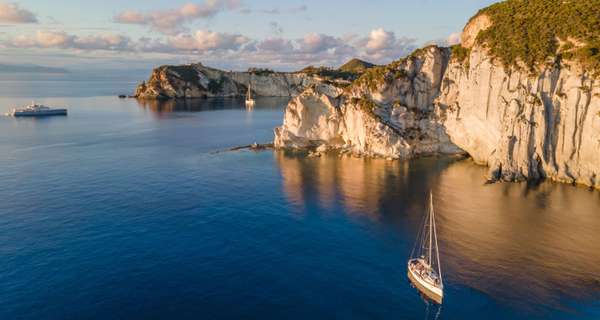
Ponza, the largest of the Pontine Islands
At 8 square kilometers, it is often the starting point for a week on the Pontines. Reach by boat Chiaia di Luna, one of the most striking spots on the island, and treat yourself to an excursion to the Grotto of the Maga Circe: mandatory dinghy to get up to the most hidden ravines and enjoy the crystal clear sea! Cala Feola and the nearby Piscine Naturali are also not to be outdone: you will find sandy and rocky bottoms and a sea so blue it looks like a swimming pool. To the east, back to Cala Felce, you can also observe Gavi Island, the smallest of the Pontine Islands, currently private. For a romantic, melancholy sunset stop at the roadstead of Cala di Lucia Rosa: named for the girl who, according to legend, let herself fall off the cliff down onto the stacks because she was hindered by her father from marrying the love of her life.
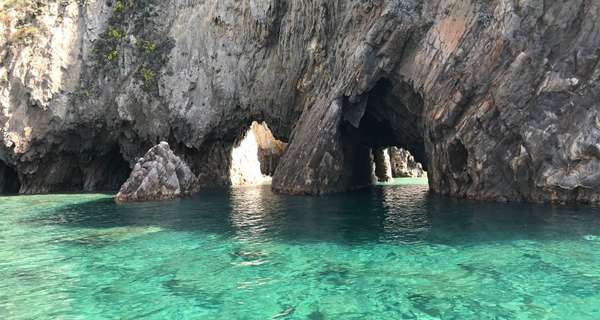
Palmarola and its rocky cliffs
Palmarola Island is small but hides some breathtaking gems, starting with Cala Tramontana with the Palmarola Cathedrals. It lies to the north of the island and is a steep cliff whose rocks, which open onto some caves, have been shaped by the sea and wind into the shape of a tall Gothic cathedral. It is a fascinating place and can only be reached by sea and discovered with a good snorkeling session. Circumnavigating the island you will arrive at Cala del Porto or O'Francese, named after the only restaurant and guesthouse on the island that overlooks this very strip of beach. From the boat you can enjoy the transparent water of this cove and spot the small houses carved into the rock. If you go ashore, on the other hand, you can treat yourself to a dinner of freshly caught fish and a nice photo on the beach swing. Sailing to the south of the island you will arrive at Cala Brigantina, with its extraordinary white rock walls, and then up to the Faraglioni di Mezzogiorno, to be discovered up close by tender to admire them in all their majestic beauty.
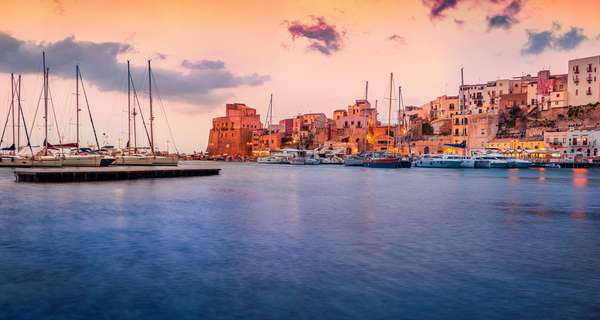
Ventotene, a dip in Imperial Rome
Nestled in the Protected Marine Park, Ventotene Island is located a few miles south of Ponza and is immediately recognizable by its pastel-colored houses and rooms carved out of the tuff overlooking the island's ancient Roman port, which is still in use today. Here you can visit Cala Nave during the day and then go ashore for an aperitif or an evening out. Also not to be missed is a visit to the ancient Roman cisterns or the remains of Villa Giulia. In September, the characteristic Festival of Santa Candida is held, a time of joy for the whole village, which comes alive to the rhythm of band music, food, wine and games of all kinds in which everyone can participate. On the last day, paper hot air balloons typical of the festival are released into the air, creating a rather atmospheric atmosphere.
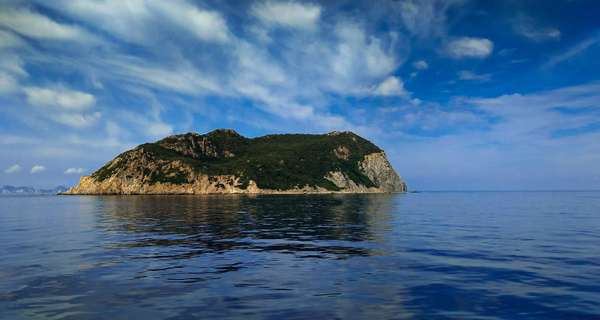
Zannone and Santo Stefano
Connected to Ponza by a strip of submerged land, the Island of Zannone is the easternmost of the Archipelago and in addition to being made up of volcanic rocks like the others, it also has metamorphic and sedimentary rocks dating back more than 200 million years: for this reason it has been part of the Circeo National Park since 1979. It is completely uninhabited and has only one landing place in the locality of Varo, features that allow the preservation of its natural environment and allow snorkeling enthusiasts to observe very rich seabed.
Santo Stefano Island, a stone's throw from Ventotene, is also completely uninhabited and wild. It is part of the Protected Marine Park, which is why anchorage is only allowed on the northern part of the island, near the old Bourbon prison, the prison commissioned by Ferdinand IV of Bourbon and in use until 1965. The site is really worth a visit, especially for those who want to be transported into the stories of this island's famous inmates.
A perfect destination for sailing and catamaran holidays




10+
Show all
6 unique places reachable only by sea in the Pontine Islands
Chiaia di Luna, Ponza
The most famous of all, it has earned its name thanks to its white cliffs overlooking a strip of sand that becomes especially fascinating at sunset when it turns pink and violet. Only those who visit Ponza by boat will have the privilege of seeing it up close, bathing in its blue-green waters and stopping for a night in the roadstead.
Natural arch of Ponza
Also called "Spaccapurpo," this is a 36-meter-high stacks that offers a breathtaking, wild panorama. A perfect place to dive at all hours of the day with mask and snorkel and explore the rich underwater depths.
Cala Spermaturo, Palmarola
A bay named after the rock of the same name that rises vertically emerging from its waters. It is home to many caves that can be visited by tender or by swimming and, above all, a very blue sea in which to take a truly relaxing swim.
Faraglioni di Mezzogiorno, Palmarola
Four immense rocks emerged not far from the western tip of Palmarola that together create a small archipelago. They are absolutely to be reached by sailboat and then to take the tender and walk around their entire perimeter, also crossing their caves, such as the Grotta di Mezzogiorno, carved out of the largest rock. The water that bathes them is crystal blue that will leave you speechless.
Moggio di Terra, Ventotene
One of the first coves visible when arriving from Ponza, its waters are deep blue thanks to its rocky seabed, perfect for swimming and discovering its marine fauna and flora.
Punta Eolo, Ventotene
Circumnavigating Ventotene, it is mandatory to pass by Punta Eolo, which marks the eastern end of the island. From below by sailboat, it is possible to catch a glimpse of the remains of Villa Giulia, an imperial villa from Roman times.
Boating vacations in Ponza and the Central Tyrrhenian Sea
Guides & tips
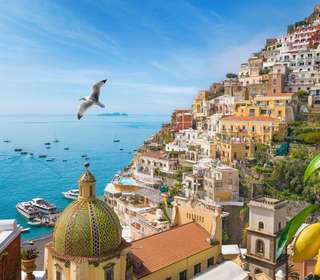
Where to travel
The Amalfi Coast by sailboat
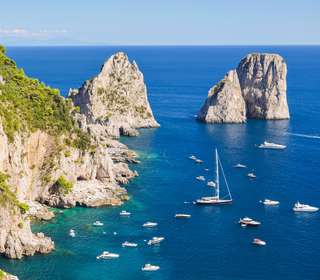
Where to travel
Capri, Ischia and Procida by sailboat
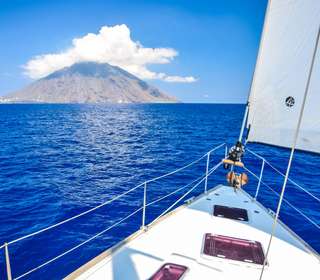
Where to travel
Italy on a sailing boat
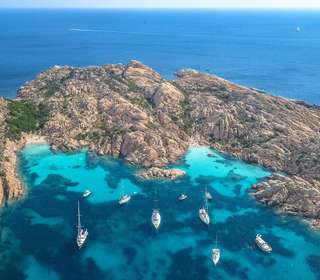
Where to travel
Sardinia on a sailing boat
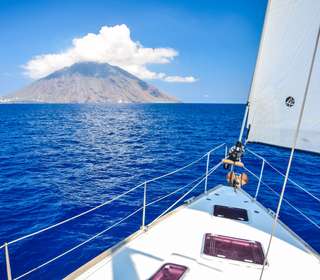
Where to travel
The Aeolian Islands on a sailboat
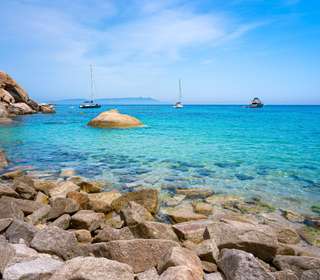
Where to travel
Tuscan Archipelago by sailboat
Let's talk Sailsquare!



Secure payments



© 2025 Sailsquare Srl SB • All rights reserved - VAT IT07860990964
